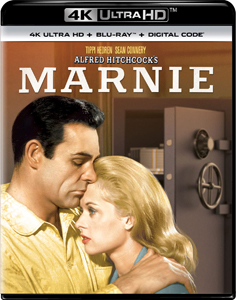“Marnie” (1964) is an uneven film with bizarre behaviors by unlikeable people, the first of Alfred Hitchcock’s final five films that lack the wide acclaim of his amazing two-decade stretch before that. Yet I can’t deny that Jay Presson Allen’s adaptation of Winston Graham’s 1961 novel – written with Hitchcock’s pet themes in mind – is quite compelling in spite of itself.
An even more psychotic ‘Psycho’
It starts off like the writers have put “Psycho” through a blender. Marnie (Tippi Hedren) – she uses aliases, but I’ll go by her given name for simplicity’s sake – steals several bundles of cash from her employer, then moves to the next town to re-invent herself.
Like Norman Bates, she has a nutso mother who she sometimes visits back in Baltimore, Bernice (Louise Latham). This mother is still alive, but Marnie isn’t exactly stable in the head – she has nightmares whenever she sees the color red.

“Marnie” (1964)
Director: Alfred Hitchcock
Writers: Jay Presson Allen (screenplay), Winston Graham (novel)
Stars: Tippi Hedren, Sean Connery, Martin Gabel
It becomes a pitch-black film in the final act when we learn a shocking thing about the title character, but “Marnie” is a fascinatingly implausible exploration of gray areas until then. Marnie is a thief, but also the sympathetic protagonist when her new bank boss, Mark Rutland (Sean Connery), catches her stealing from the safe.
This is one of the great acting mismatches of all time, with Connery being his usual sexiest man alive and Hedren standing there like a statue except when the camera is tight on her and she bursts into a performance. Similar to how I wished for more Suzanne Pleshette in “The Birds,” here we have Diane Baker’s brunette Lil slinking around the background, stealing scenes from the blonde.
Although Lil could’ve used more characterization, it’s not horrible that Hedren is stiff, because it fits the character and Hitch’s desire to craft a style piece around the actress as Marnie goes catatonic whenever seeing red or experiencing a thunderstorm. Also along style lines, a memorable piece of suspense comes when the camera sets up with Marnie busting into the safe on one side of a dividing wall and the janitor lady beginning her duties on the other side.
Marnie’s Sophie’s choice
Contrasting criminal protagonist Marnie is helper antagonist Mark. To a point. He gives Marnie a Sophie’s choice: He can simply turn her in to the police, or she can marry him and be free of legal worries. She chooses the latter, but not wholeheartedly.
“Marnie” is a good portrayal of how people can only be helped if they want to be helped. And putting conditions on the help, well, that doesn’t help. Whether Mark is a good guy or bad guy is confusing; he’s both, but ultimately in a way that leans toward shaky writing more so than an honest portrayal of a human being’s inconsistency.

Although it’s staged in a censorious way that calls to mind earlier Hitchcock films, Mark seems to rape Marnie at one point. Or at least Marnie is not totally on board with the sexual encounter. She freezes like a statue, even more so than Hedren’s usual acting approach.
But later, Mark truly does help Marnie confront and address her tragic past, in a world where no one else would give her the slightest benefit of the doubt. Forcing her to marry him is bizarre and wrong, but throw out that and the rape, and all his actions objectively point toward helping and saving Marnie.
It’s hard to know how to feel by the end of “Marnie” in regard to the question of right and wrong, and the question of whether this is a good movie or a bad movie. Marnie’s and Mark’s strange behavior got the gears of my mind spinning out of control like Marnie when seeing red, so I give it the benefit of the doubt. But I can see why a movie about a savior rapist gets mixed reviews.
RFMC’s Alfred Hitchcock series reviews works by the Master of Suspense, plus remakes and source material. Click here to visit our Hitchcock Zone.

